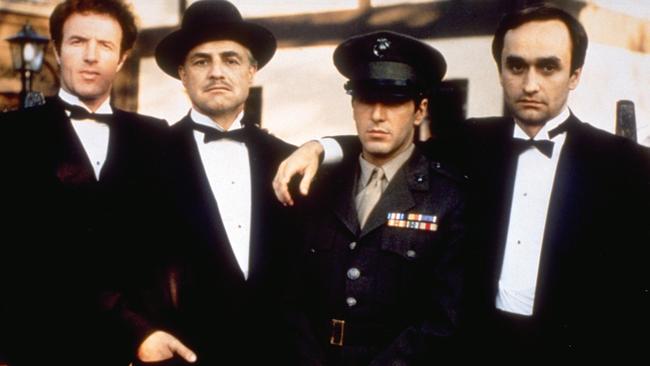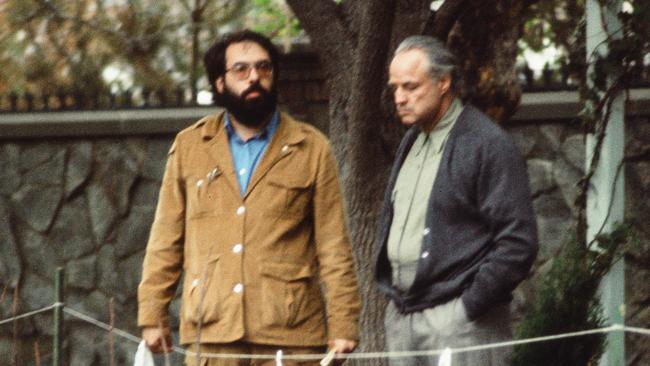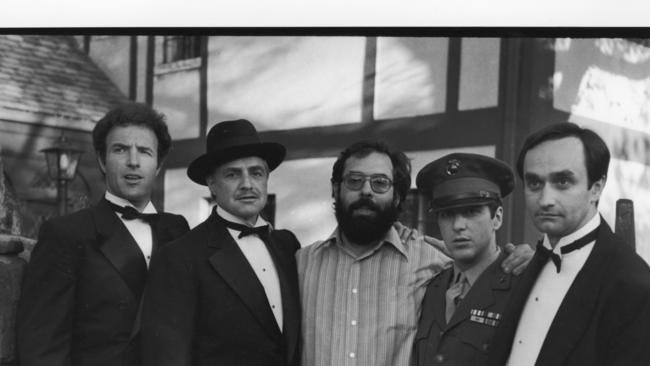How The Godfather defied the odds and is still the greatest movie ever made 50 years later
Ahead of its release 50 years ago, The Godfather looked destined for disaster — instead it became the greatest movie of all time. Here’s how. TAKE OUR QUIZ.

Movies
Don't miss out on the headlines from Movies. Followed categories will be added to My News.
Fifty years ago on Monday, the film world made an offer that audiences couldn’t refuse when The Godfather had its world premiere in Hollywood.
Although it was adapted from Mario Puzo’s best-selling novel about powerful a New York Mafia don and his three sons, which had been released three years earlier, nobody had particularly high hopes for the end point of what had been a troubled journey to the big screen.
Big name directors (12 by some reports) had turned down the job before Italian-American auteur Francis Ford Coppola was hired. Coppola himself had first knocked it back but then relented when he realised he needed the money – and proceeded to clash with the studio over key casting choices and creative decisions such as when and where it would be set, and was nearly fired from the project on more than one occasion. Crime boss Joe Colombo and his organisation, the Italian-American Civil Rights League, started a campaign to stop the film from being made and even crooner Frank Sinatra leaned on his mob friends to threaten the people involved.

Certainly, there was nothing to suggest what was to come. When The Godfather opened in the US on March 24, 1972, it was a critical and commercial smash with queues around the block to see it from day one. It won the Best Picture Oscar and Best Actor Oscar for Marlon Brando – who played Godfather Don Corleone – the following year and earned nominations for Coppola as director and Best Supporting Actor nods for Al Pacino, James Caan and Robert Duvall, playing reluctant mafia heir and youngest son Michael, hot-headed oldest child Sonny and adopted son and consigliore Tom Hagen respectively. The Godfather and would go on to spawn two sequels and become the highest grossing film of all time, a title it would hold until dethroned by Jaws three years later.
But more importantly, its stature has only grown over time. Not only did it inspire a whole genre of Mafia movies, including future classics Goodfellas and The Sopranos (both of which referenced it reverentially), it became part of the fabric of pop culture. Even people who have never seen The Godfather know about the infamous horse head in the bed and lines such as “I’ll make him an offer he can’t refuse” and “leave the gun, take the cannoli”. Unsurprisingly in 1990 it was selected for preservation in US National Film Registry of the Library of Congress for being “culturally, historically or aesthetically significant and frequently tops lists of the greatest films ever made.

SMARTdaily film reviewer Leigh Paatsch says that’s a title that Coppola’s masterpiece richly deserves, arguing that it remains the gold standard that filmmakers still aspire to even after half a century and will continue to do so well into the future.
“It’s a film that sets a very high benchmark in every element of filmmaking, whether it be the production design, the costume, the standard of acting, the writing, the lighting, the pacing – there is nothing you can really say hasn’t stood the test of time or doesn’t work,” he says.
“You can bet your bottom dollar that in 50 years from now, nobody will be saying ‘I want to make the next Power of the Dog or the next Belfast or Birdman’ but you can guarantee that there will be a filmmaker in five decades time saying ‘I want to make the next Godfather’.”
Coppola disliked Puzo’s book when he first read it but was determined to bring the authenticity of his Italian-American heritage to his film, although they were artists rather than mobsters. He famously held improvisational rehearsal sessions in which the main cast sat down for a family meal. The actors couldn’t break character, which Coppola saw as a way for the cast to organically establish the family roles.
“I knew what it was like to live in an Italian American household,” Coppola says. “The day-to-day routine, what the meals were like, the fact that we used to also eat takeout Chinese food. I tried to give a sense of authenticity to all the life in the movie based on my own experience of my own family.”

It’s that authenticity, plus the timeless themes of family and good versus evil that puts The Godfather in a class of its own according to Paatsch, who says he can see echoes in modern entertainment from the “family-is-everything” mantra of the latter Fast and Furious movies to the epic power struggles and shifting alliances of the recent HBO hit Succession.
“The universal nature of storytelling is very much embodied in the concept of family in the Godfather and people immediately plug into that,” Paatsch says of The Godfather’s continuing appeal.
“People from all walks of life immediately understand the nuance of power dynamics but also the crazy dysfunction that exists within a family like the Corleones. No matter what nationality you are or what your upbringing is, variations of what you see inside The Godfather and different twigs that snap off the family tree pretty much mirror in some way your own experience.”
Newly restored and remastered versions of The Godfather Trilogy are available on 4K Ultra HD, Blu-ray and 4K Digital from March 23.

GODFATHER FACTS
Mario Puzo wrote a personal letter to Marlon Brando, telling him he was the only person who could play The Don, even though studio Paramount Pictures thought he was box office poison and didn’t want him cast.
Brando wanted to make Don Corleone look “like a bulldog,” so he stuffed his cheeks with cotton wool for the audition. For actual filming, he wore a mouthpiece made by a dentist; this appliance is on display in the American Museum of the Moving Image in Queens, New York.
The wedding scene that opens The Godfather took four days to shoot and employed at least 350 extras.

The cat held by Brando in the opening scene was a stray that Coppola found at Filmways Studio in Harlem, NYC. It purred so loudly during the scene that dialogue had to be re-recorded.
The exterior of Jack Woltz’s (the studio exec who wakes up with a horse head in his bed) home was shot in Beverly Hills at the Hearst estate. The same property was also used in The Bodyguard and Fletch.
Brando and Robert De Niro were the first actors to win Oscars for playing the same character in different movie, with the former winning Best Actor as Vito Corleone in The Godfather and the latter winning Best Supporting actor as the young Vito in The Godfather Part II. Heath Ledger and Joaquin Phoenix have since both won Oscars for playing different versions of The Joker.
Sonny’s death was the most expensive scene in the movie, costing $100,000. James Caan wore 127 blood-filled explosive squibs to simulate bullets hitting him and the car had over 200 pre-drilled squib holes.

Many famous actors failed to be cast in the film. Warren Beatty, Dustin Hoffman, Jack Nicholson, Robert Redford, and Robert De Niro were all considered for Al Pacino’s part of Michael.
Coppola’s mother, father, sister, wife and sons are all in The Godfather. Three-week-old daughter Sofia played the ‘baby Michael Rizzi’ in the baptism scene of The Godfather, was an extra in The Godfather: Part II, and played Mary Corleone in The Godfather Part III before becoming the Oscar-nominated director of Lost In Translation.
The words “mafia” and “mob” aren’t uttered in The Godfather.
More Coverage
Originally published as How The Godfather defied the odds and is still the greatest movie ever made 50 years later




